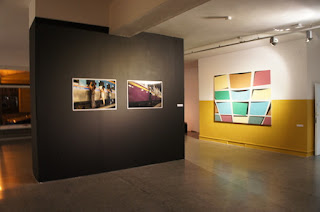The participants visited also Sopot - the National Gallery of Art, artist's union 'Dwie Zmiany' and met Emilia Orzechowska from Art Loop Festival.
2 lis 2015
Artists' Colony
There was also presentation of the Artists' Colony which was founded in 2001. It was established by the group of artists and cultural animators in the areas of former Gdansk shipyard. The Foundation is involved in projects where the main work tool is the culture and art. The leading activities includes artistic, music and socio-cultural projects, as well as popularization and promotion of art including niche, avant-garde and non-commercial.
After the presentation the participants met artists who are currently live and work in Gdansk.
Gdansk City Gallery
The participants also visited the Gdansk City Gallery - its three brunches.
Gunter Grass Gallery houses a collection of the Nobelist's 129 art pieces. The foundation of this collection was a gift from Grass to the City of Gdańsk in 2007 which included 51 graphics and 6 sculptures. In 2009 the Günter Grass Gallery in Gdańsk was established in order to store and present these works of art.
Gdansk City Gallery 1 and 2 was currently presenting “Friends from the Seaside”. The exhibition is another opportunity for Friends to meet and an attempt to restore a specific format of collective artistic activity. The first part of the exhibition (1st – 31st of August) features archival works: paintings, films, murals, photographs made between 2002 and 2004. During the show, a plein-air is planned by the Motława (1st – 7th of August). Works created during the plein-air are exhibited in the second chapter of the exhibition that runs between 11th of September and 11th of October 2015.
22 paź 2015
Wyspa Institute
The next place we have visited was the Wyspa Institute (http://www.wyspa.art.pl/). Wyspa Institute of Art, founded in 2004 and run by the Wyspa Progress Foundation in Gdańsk, accommodated on the premises of the former Gdańsk Shipyard is the first Polish non-commercial and non-governmental institution of an international profile, devoted to the issues of contemporary artistic culture. Its character and programme grows directly from the specificity of the venue where it is located – its history and tradition, on the one hand, and its projected future, on the other. Bearing in mind many failed revitalisations in Europe, the creators of the Institute apply critical tools, both practical and theoretical, in the assessment of all the phenomena happening around. We have met Grzegorz Klaman who presented us the history of the Wyspa and its current exhibition "Wyspa 3.0 - Map and Territory" - showing 30 years of Wyspa with works by Jarosław Bartołowicz, Kuba Bielawski, Oskar Dawicki, Jarosław Fliciński, Angelika Fojtuch, Grupa i inni (Mira Boczniowicz i Andrzej K. Urbański), Ellen Harvey, Mamet Hektor, grupa Low Res, Elżbieta Jabłońska, Robert Jurkowski, Ania Kalwajtys, Grzegorz Klaman, Tomasz Kopcewicz, Kazimierz Kowalczyk, Julia Kurek, Konrad Kuzyszyn, Leszek Lewandowski, Zbigniew Libera, Jacek Niegoda, Dorota Nieznalska, Hanna Nowicka, Maureen O’Connor, Monika Pudlis, Konrad Pustoła, Anna Reinert, Robert Rumas, Jadwiga Sawicka, Roland Schefferski, Dominika Skutnik, Marek Sobczyk, Jacek Staniszewski, Andrzej Syska, Eugeniusz Szczudło, Michał Szlaga, Grzegorz Sztwiertina, Marek Targoński, Twożywo, Ania Witkowska, Agnieszka Wołodźko, Krzysztof Wróblewski, Piotr Wyrzykowski, Dorota Zgłobicka, Ryszard Ziarkiewicz, Alina Żemojdzin, Artur Żmijewski.
20 paź 2015
Laznia Center for Contemporary Art
The participants visited Laznia Center for Contemporary Art (http://laznia.pl/) in Nowy Port - its gallery space, cinema, workshops and residency rooms.
The Łaźnia Centre for Contemporary Art was one of the first public cultural institutions established in Poland after the transformations of 1989. It began as an initiative by local independent artists opposed to traditional models of art. Their only chance to realize their projects was to create their own art space – one free from censorship, prejudices, stereotypes and inhibitions. An old and dilapidated former public bathhouse on Jaskółcza street first opened in 1908, turned out to be an ideal space for showing art. In response to a grassroots initiative by artists, in 1998 the Gdańsk City Council designated it a municipal cultural institution: the Łaźnia Centre for Contemporary Art.
Łaźnia 2 Centre for Contemporary Art - Centre for Art Education, where, in addition to visiting exhibitions, visitors can take advantage of an art reading room, library, open animation studio, and cinema, and attend a wide range of classes and workshops.
Alternativa and Museum of Contemporary Art with Aneta Szylak
Aneta Szylak, the artistic director of the Alternativa http://alternativa.org.pl/, has presented the last few editions that took place in the dockyards. Alternativa are constantly seeking new paths of art and its social role. Each year, they undertake activities to strenghten the relations between local context, the problems of the contemporary world, the work of artists and everyday curatorial practice.
The plans for the new Museum of Contemporary Art was also discussed.
European Center of Solidarity
The research trip in Gdansk has started in the European Center of Solidarity which has served as a great and resourceful introduction towards Gdansk context. The ECS is located in the dockyards and presents the most important historical moments in the recent history of Poland - the Solidarity movement and the end of Communism. The guided tour was mainly focused on the historical narrative as well as on its models of display.
Subskrybuj:
Posty (Atom)


























